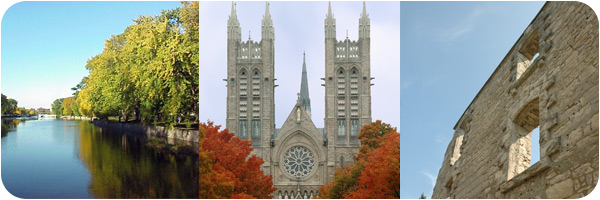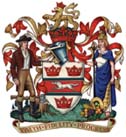On this page

History
Guelph is situated on treaty land that is steeped in rich Indigenous history. Archaeological evidence indicates Indigenous Peoples were present in the area now known as Guelph as early as 11,000 years ago. Up until their collapse in the 15th century, the Attawandaron, commonly known as the Neutral peoples lived, farmed, and hunted here. In 1690, the Mississauga peoples entered the area. The land was purchased from the Mississaugas of the Credit First Nation of the Anishinaabek Peoples by the British in 1784; this transfer of land is covered by an Upper Canada Treaty No. 3, 1792.
Learn more about Guelph’s Indigenous history and read the City of Guelph Territorial acknowledgement.
On St. George’s Day, April 23rd, 1827, the city now known as Guelph was founded by the British development firm known as the “Canada Company” with the ceremonial felling of a large maple tree. Guelph is considered to be one of the first planned towns in Canada, and the location was picked to serve as the Company’s headquarters by its Superintendent in Canada, a popular Scottish novelist named John Galt. Galt designed the town to attract settlers to it and to the surrounding countryside. Galt’s plan was quite imaginative, based on a series of streets radiating from a focal point at the Speed River, and resembles a European city centre, complete with squares, broad main streets and narrow side streets, resulting in a variety of block sizes and shapes. Galt chose the name “Guelph” for the new town because it was one of the family names of the British royal family, and it had apparently never been used as a place name before. Hence the current use of the term “The Royal City” for Guelph.
Despite John Galt’s grandiose plans, Guelph did not grow beyond village size until the Grand Trunk Railroad reached it from Toronto in 1856. After this time, many of Guelph’s prominent buildings were erected, a number of which were designed by high profile Toronto-based architects, but most of which were the product of a talented group of local architects, builders and stone carvers who effectively used Guelph’s locally quarried, warm-hued limestone which today gives a visual unity to the older parts of the City.
The Coat of Arms

In preparation for Guelph’s proclamation as a city on April 23, 1879, the Town Council adopted a coat of arms. On the left side was an axeman standing beside a tree stump, representing John Galt’s ceremonial felling of a mighty tree to create Guelph. On the right side, Britannia, with gown, helmet and shield, represented Guelph’s links with the United Kingdom. She held a cornucopia containing the bounty of the rich soil of Guelph. In the centre, as Guelph’s arms, was a shield with the symbolic white running horse of Hanover, the ancient principality in Germany where the Guelph royal connections go back 1,000 years. On top was the supposed Guelphic crown with a lion on it.
While the coat of arms was used extensively, it was unofficial. In 1977, to commemorate Guelph’s 150th anniversary, the City decided to redesign and register Guelph’s crest. A well-known artist, Eric Barth, assisted by a panel of local historians, updated the coat of arms and corrected heraldic and historic errors. It was approved and made official in 1978.
Facts about Guelph courtesy of Guelph Museums
- Guelph is situated on treaty land that is steeped in rich Indigenous history, and is the traditional territory of the Mississaugas of the Credit First Nation of the Anishinaabek Peoples. Guelph is home to many First Nations, Inuit and Métis people today.
- Guelph was named after the British Royal Family. King George the IV, the monarch at the time of Guelph’s founding, was from the Guelph lineage, a German family.
- Guelph was the home of North America’s first cable TV system. Ted Metcalf created McLean Hunter Television and their first broadcast was Queen Elizabeth’s Coronation in 1953.
- Guelph’s police force had Canada’s first municipal motorcycle patrol. Chief Ted Lamb brought back an army motorcycle he used during the First World War. Motorcycles were faster and more efficient than walking.
- Guelph’s police force was the first to have two-way car radios.
- Guelph City Council set up Canada’s first city manager system. The system’s creator, John McVicar, later became the secretary of the League of American Municipalities.
- Guelph city planners conceived a way to easily convert units into condominiums. Chicago was so impressed with the system they used it as a model for their city and it has since become a North American standard.
- Guelph had one of Canada’s first militia units of gunners in 1866.
- Guelph was home to Canada’s first army cadet corps and the year of its founding became part of their name – the 1882 Wellington.
- Tim Ryan, the inventor of Five Pin Bowling, was a Guelph resident.
- GCVI had Canada’s first high school lunch cafeteria.
- Guelph is the first and only municipality in the British Commonwealth to own its own railway line. The line is a 16 mile link to the Guelph Junction Railroad and the CPR. Guelph still owns it today.
- The jock strap was invented here… created by Guelph Elastic Hosiery (now Protexion Industries) in the 1920s. The company held a contest to name the product and jock strap was the winning name. The prize was five dollars.
- 1460 CJOY was the first Canadian radio station to have a call-in talk show.
- The wire coat hanger was invented here in the 1920s, probably by Steele’s Wire Spring Company.
- The Ontario Veterinary College is the oldest school of its kind in the Western hemisphere (founded in 1862).
- Colonel John McCrae, who wrote the poem “In Flanders Fields” was born and raised in Guelph.
- Riverside Park was named by priest William Carroll who was the winner of a contest to name the new park in 1905.
- P.T. Barnum’s circus came to Guelph in 1879.
- Sir John A Macdonald owned 50 acres of land in St. Patrick’s Ward in 1854.
- Baker Street was named after Wellington District’s first inspector of weights and measures – Alfred Baker – who was a Guelph resident.
- Until 1868, horses were used to operate the Mercury’s printing press. In 1868 a steam engine was installed to operate the presses.
- The number “64” on the cap of Sleeman Cream Ale bottles is the page number of the recipe from the book belonging to the great grandfather who started the company in 1832.
- Led by potato breeder Dr. Gary Johnston, a research team at the University of Guelph created the Yukon Gold, the first Canadian-bred potato to be marketed and promoted by name. It received a Canadian license in 1980.
- The HMCS Guelph was commissioned into the Royal Canadian Navy on 9 May 1944. This Flower Class corvette worked as an escort between Halifax and several U.S. ports before conducting escort duties between St. John’s, Newfoundland and Belfast, Northern Ireland. HMCS Guelph was awarded battle honours for Atlantic 1944-45. At the end of the war, she was paid off in June 1945 and sold in October 1945 to a private firm. She was last noted in Lloyd’s Register for 1964-1965 as Burfin, a name she had borne since 1956
